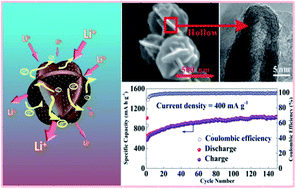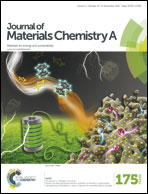Hierarchical Zn3V3O8/C composite microspheres assembled from unique porous hollow nanoplates with superior lithium storage capability†
Abstract
Fabricating hollow/porous structures and coating carbon on their surfaces are two effective strategies to improve the electrochemical properties of electrode materials for lithium-ion batteries (LIBs). In this work, we report the successful synthesis of novel hierarchical Zn3V3O8/C microspheres assembled from unique porous hollow nanoplates via a facile reverse microemulsion method and a subsequent annealing process. Notably, the PVP assisted heterogeneous contraction effect plays an important role in the formation of the distinctive hollow structure in the constituent nanoplates during the annealing process. Impressively, the resulting Zn3V3O8/C composite shows excellent electrochemical performance with a large capacity (912 mA h g−1 at 0.4 A g−1), excellent rate behavior (410 mA h g−1 at 3.2 A g−1) and cycling stability (756 mA h g−1 at 1.6 A g−1 after 500 cycles) when evaluated as the anode material for LIBs. The superior electrochemical performance of the as-synthesized Zn3V3O8/C microspheres can be attributed to the existence of carbon on the surface and, in particular, the unique porous hollow nanoplate structure.



 Please wait while we load your content...
Please wait while we load your content...